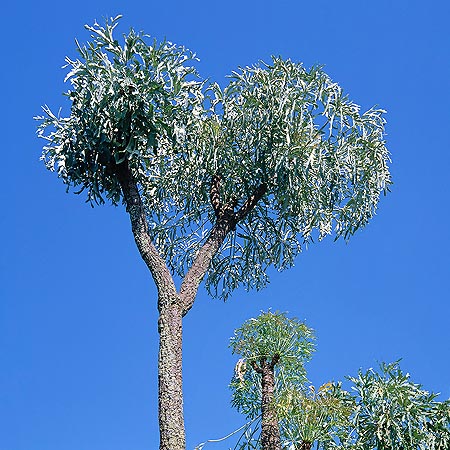Family : Araliaceae

Text © Pietro Puccio

English translation by Mario Beltramini

South African small tree, decorative and with medicinal properties © Mazza
The plant is native to southern Africa: Botswana, Lesotho, South Africa (Cape Provinces, Northern Provinces, KwaZulu-Natal) and Swaziland, where it grows till 2.000 m of altitude in the savannas and the mountain slopes, usually in the rocks fissures.
The genus is honoured to the French botanist Pierre Cusson (1727-1783); the name of the species comes from the Latin “paniculatus” = which carries panicles, with reference to the inflorescence.
Common names: “cabbagetree”, “highveld cabbage tree”, “little cabbage tree”, “mountain cabbagetree” (English); “bergkie- persol” (Afrikaans); “cussonia paniculé” (French); “Südafrikanische Kohlpalme” (German).
Small evergreen, not much ramified, tree, growing to about 6 m tall, with tuberous roots and stocky, nodose stem, of about 60 cm of diameter, enlarged at the base (pachycaule), and with a greyish, deeply fissured bark; the leaves, assembled at the extremity of the branches, on up to 60 cm long petioles, are palmate-compound of a green-grey colour, coriaceous and waxy, with 7-11 lanceolate leaflets, 12-30 cm long and 4-8 cm broad, with sharp apex and entire margins (subsp. paniculata), or deeply lobed (subsp. sinuata).
The inflorescences are terminal panicle, with a main axis, long about 40 cm, and the greenish flowers united in several and thick cylindrical spikes of about 10 cm of length; globose fruits of about 6 mm of diameter, of a dark purple colour when ripe.
It usually reproduces by seed, which has a short-lasting germination time (three months about), to be placed in deep containers for allowing the tuberous root to develop; it reproduces also by cutting, but in this case it does not form the enlarged base.
Moderately growing plant, very decorative due to the form and colour of the leaves and the typical longitudinally fissured stems, it is suitable for tropical, subtropical and warm temperate climates, as it bears temperatures as low as about -6 °C for short time, to be planted isolated, in order to exalt its characteristics, in full sun on rich and draining soils; when adult, it can stand drought periods without damage.
In pot, which must be rather capacious, it is to be cultivated in sandy and draining substrata with the maximum possible luminosity, with temperatures never under the 10-12 °C; watering must be moderate during the vegetative period and reduced in winter.
Due to the stem, which can easily assume contorted forms, and the succulent roots, it is an appreciated subject for the collectors of caudiciform plants and for creating bonsai.
In the countries of origin, the leaves are utilized as forage and the plant holds a certain importance in the traditional medicine; recent studies have shown the presence in several parts of the plant, in particular bark and leaves, of bio-active principles of possible interest in pharmacology.
→ To appreciate the biodiversity within the ARALIACEAE family please click here.
